At the heart of most RVs lies a fairly complex electrical system powering everything from the refrigerator to the water pump to the lights to the electric outlets and more. In this post, we offer a guide to the RV electrical system, a sort of “RV Wiring for Dummies” (no offense meant!)
We’ll unravel the details of an RV’s electrical system, review its components and their functions, and how it all comes together to power your home on wheels.
RV Wiring for Dummies
First, note that we’re using the title “RV Wiring for Dummies” as a play on the popular “…For Dummies” series of books. We’re providing a basic understanding of RV electrical systems, which have some complex components, and function in ways unlike regular “sticks & bricks” houses.
One reason RV electrical systems are complicated is that power is needed whether your rig is connected to shore power, or you’re boondocking off the grid (where you’re relying on a generator or your house battery bank for electricity). RVs also use both 120V AC, like a house, and 12V DC, like a car.
AC vs DC Power in an RV
It’s important to know the difference between AC (alternating current) and DC (direct current). These two types of power play specific roles in the system, supplying power to different appliances, devices, and parts of the RV.
Complicating things is that some RV equipment can require both AC & DC at the same time. An RV fridge on shore power is a good example. It uses 120V AC to keep the fridge cool, and 12V DC to run the electronics that control it.
Alternating Current (AC Power)
Let’s break down what we need to know about AC power as it relates to an RV.
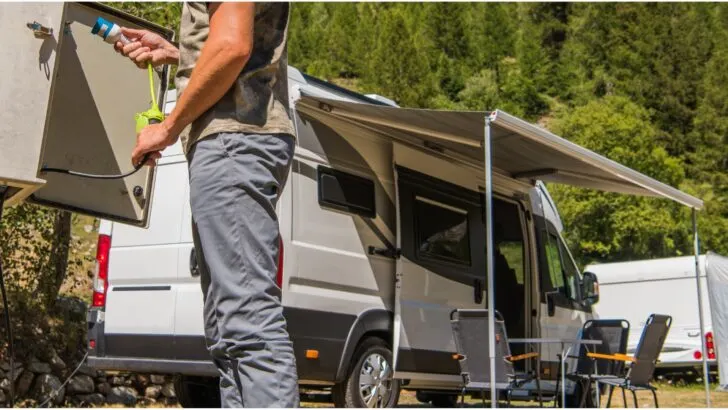
For 120V AC power, you either need to be connected to shore power, run a generator, or depend on your “house” battery bank to power an inverter, which transforms 12V DC power into 120V AC power.
AC Voltage
AC power in North America is rated at 120 volts. In Europe, Australia, New Zealand, and many other countries, the power used is 240 volts. Regardless of what country you’re in, these voltages are alternating current. It’s the power used in typical homes, where everything from lightbulbs to washing machines to hair dryers is powered by it.
AC Power Sources
In an RV, AC power is the type of electricity supplied by your shore power cord when it’s plugged into power pedestals at campgrounds or home electrical outlets. AC power is also produced by a portable or onboard generator.
AC power can also be produced from DC power in an RV by using a device called an inverter. This clever device transforms 12-volt DC power from your house battery bank into 120-volt AC power. That allows you to run 120V AC appliances off 12V DC batteries.
That means you can run a 120V microwave oven, TV, coffee maker, or hair dryer without any access to shore power or a generator. The power to keep the batteries charged is often supplied by solar panels. A great thing about using an inverter to create 120V AC from 12V DC is that it’s virtually silent. For more complete information about what an RV inverter is and how to use it, see our post “What Is an RV Inverter?”
AC Appliance Usage
In general, appliances that use motors or compressors (air conditioners and residential refrigerators, for example), rely on 120V AC power. Other common 120V AC appliances are those you’d find in almost any typical home: hair dryers, blenders, and many coffee makers for example.
RV refrigerators and water heaters can also run on 120V AC power, although they are usually able to run on propane as well. But, as mentioned above, even when using 120V AC shore power at an RV park with power hookups, some appliances also rely on 12V DC power to function.
RVs that have hydronic heating systems often include a separate 120V AC heating element to augment the supply of hot water and/or onboard heat as well. This would also apply if you’ve upgraded with the CheapHeat Add-on to convert your RV furnace to electric.
AC Power Distribution
AC power is distributed through the RV’s electrical system via AC circuits, similar to a typical home. Distribution panels manage the flow of AC power, directing it to various outlets and appliances. You’ll almost certainly find at least one circuit breaker box in every RV that resembles the breaker panel in a sticks & bricks house. They carry the same 120V AC power through familiar circuit breakers that are tripped and reset the same way.
Direct Current (DC Power)
Now let’s break down what we need to know about the DC system as it provides power to an RV.
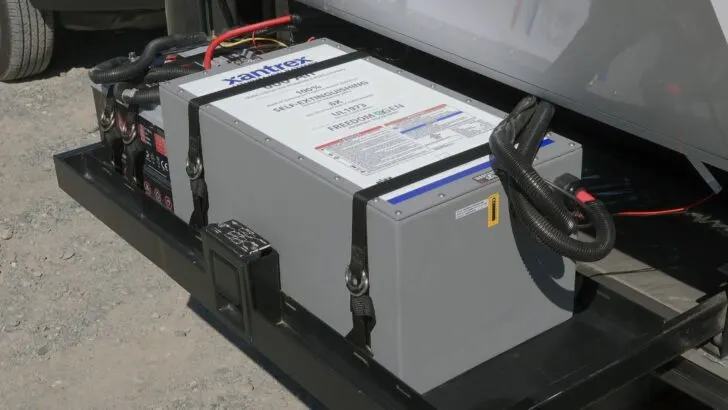
Our Newmar motorhome has a Xantrex Freedom eGen lithium “house” battery. It stores and produces 12V DC, similar to a typical car battery. We can use it to power 12-volt gear, such as the water pump and LED lightbulbs. It can also power 120V AC appliances by way of our Xantrex inverter.
DC Voltage
DC power on an RV operates at lower voltages, typically 12 volts in RV electrical systems. That’s the same 12V DC found in the average automotive battery. Other than smaller or older Class B or van conversions, motorhomes usually have two types of batteries: one to start and run the engine, with the other being deep-cycle batteries to power items on board. These are typically referred to as “house” batteries because they feed the house portion of the RV vs the chassis portion (similarly, the engine battery is often referred to as the “chassis battery” in a motorhome).
DC Power Sources
DC power for the house portion of an RV is primarily supplied by the RV’s deep-cycle battery bank. These may be flooded lead acid, AGM, gel, or lithium batteries. Whichever type you have, they all serve the same purpose — providing power to the living area of the RV.
An RV’s DC power system also includes a battery charger/converter, 12V wiring, switches, and possibly solar panels and a solar charge controller for recharging the battery bank. Again, it can also include an inverter to transform the 12V DC into 120V AC.
DC Appliance Usage
Many smaller appliances and essential systems within the RV, such as lights, water pumps, and vent fans, rely on 12V DC power. 12V television sets have become more common as well. In addition to 12V appliances, controls that manage the electronics/brains in appliances like RV fridges, water heaters, air conditioners, and furnaces also rely on 12V DC power, as do slide-out motors and electric steps.
As mentioned, a vehicle’s engine and chassis systems use DC power from the engine/chassis/start battery.
DC Power Distribution
DC power is distributed through the RV’s electrical system via DC circuits. These circuits connect to various components that require lower voltage for operation. As a result, you’ll find at least one panel with automotive-style 12-volt fuses in an RV. All of the wiring, fuses, and other components that are part of this system are rated to handle that lower 12V DC power.
Integration of AC and DC Power
As we noted above, some parts of the RV electrical system and some appliances require both AC and DC power to run. For this reason, RV electrical systems are designed to seamlessly integrate both AC and DC power to meet the diverse energy needs of the rig. This integration ensures the ability to use high-voltage (120V AC) appliances while still powering essential systems through low-voltage (12V DC) sources.
Air conditioners are a good example. With an RV air conditioner, the compressor and blower fans generally run on 120V AC power. This means that without shore power, a generator, or a substantial inverter & battery bank, you can’t run them.
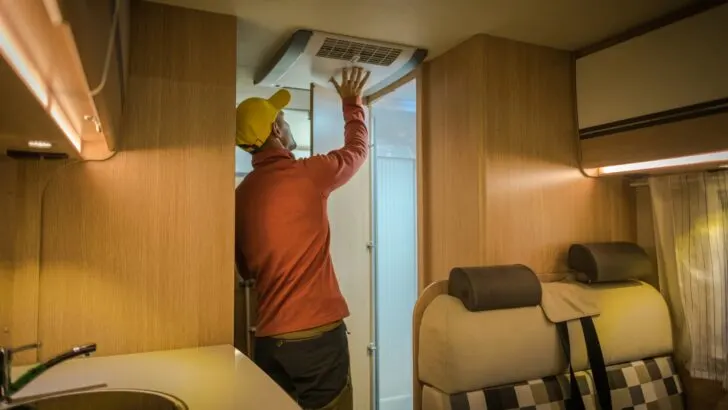
Most RV air conditioners require 120V AC power to run, (although there are a few 12V DC RV air conditioners on the market now). But even 120V RV air conditioners require some 12V DC power to run and control the electronics, including the thermostat.
However, the air conditioner’s electronic controls, including the thermostat, run off of 12V DC power. So without 12V DC, they won’t work, even when hooked up to shore power. The integration of these crossover items can be a bit confusing, so let’s break down the inversion/conversion process briefly.
Inverter / Inverter-Charger
To bridge the gap between AC and DC power, many RVs include an inverter in their electrical systems. As mentioned earlier, the inverter takes 12V DC power from the house battery bank and transforms it into 120V AC power to run 120V AC appliances. This allows the use of those appliances even when the RV isn’t connected to shore power or running a generator.
Many inverters also include a battery charger, allowing them to perform double duty — powering appliances off the house battery bank and charging the batteries when on shore or generator power. These units are known as inverter-chargers since they do both jobs.
Battery Charger/Converter
A battery charger/converter uses 120V AC power from a shore connection or an onboard or portable generator. It converts that power to 12V DC to recharge the RV’s batteries and/or supply 12V DC power to the RV.
For much more information, see our complete post on the RV power converter as well as our comparison guide on the RV converter vs battery charger.
RV Electrical Power Sources
RVs typically have multiple power sources to ensure flexibility and independence. Whether you’re connected to shore power or boondocking off the grid, your RV’s electrical system can provide the power you need.
The primary sources of electrical power to an RV include the following:
Shore Power
When parked at a campground or RV park, most RVs can connect to shore power. This involves plugging the RV into a power pedestal using an RV power cord.
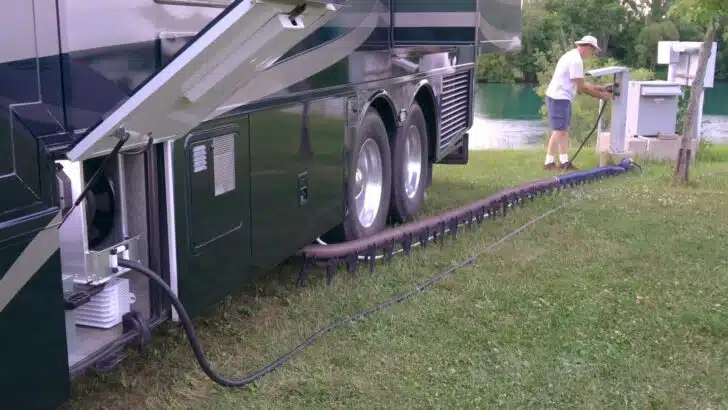
Here’s Peter plugging our Newmar Mountain Aire into 50A shore power at a campground.
Shore power provides a continuous and reliable source of electricity, allowing the RV’s batteries to charge, and all appliances and systems to operate without drawing power from the onboard battery bank. For more, see our post Do RV Batteries Charge When Plugged Into Shore Power?
You can also plug an RV into a typical home electrical outlet rated at 15A or 20A. This usually requires a few considerations such as using a dog-bone power adapter and limiting your power consumption to avoid tripping the circuit breaker. For more on this topic, see our post on moochdocking.
The following adapter will allow you to plug a 30-amp RV into a 15- or 20-amp household electrical outlet:
- CONVERTS ELECTRICAL CONNECTION TYPE: Easily hookup your 30-amp RV to a campground's power pedestal or an at-home 15-amp outlet with Power Grip’s...
- HIGH CONDUCTIVITY: Rated for 125 volts/1875 watts, the RV power adapter features 100% copper 10/3-gauge wires for superior conductivity. It includes...
The adapter below allows the owner of a 50 amp RV to plug their rig into a 30 amp campground power pedestal. But adding it to the adapter above (using both at once) will enable you to plug a 50-amp RV into a normal household outlet as well.
- Converts Electrical Connection Type: Designed to allow you to hookup to your campground's power pedestal, adapting the electrical connection to fit...
- High Conductivity: Heavy-duty 30-amp male (NEMA TT-30P) and 50-amp female (NEMA 14-50R) electrical heads. Rated for 125 volts/3750 watts. Constructed...
We’ve always carried both of these adapters, allowing us to plug our 50-amp rig in just about anywhere. Our video Dog Bones 101 shows how this all works, regardless of what your RV’s power plug looks like and what shore power is available.
Onboard or Portable Diesel, Gasoline, or Propane RV Generators
Many RVs are equipped with built-in generators that run on gasoline, diesel, or propane. Whether your rig has a built-in generator or you use a portable model, generators provide an on-the-go power solution. They allow RVers to operate electrical appliances and charge batteries even when camping in remote locations without access to shore power.
RV “House” Batteries
Most RVs also have deep-cycle house batteries. These may be flooded lead acid, gel/AGM, or Lithium batteries. As mentioned, these are separate from a motorhome’s engine/starting battery.
RV house batteries store electricity for use when the RV isn’t connected to an external power source. They power lights, water pumps, and various 12-volt appliances. Also mentioned above, many RVs also have an inverter to transform stored 12V DC power into 120V AC power for standard household devices.
Many RVers (including us) love the freedom we get from installing a large battery bank… especially lithium batteries, which are far superior to other types. Adding a large solar array to keep those batteries charged allows us to stay off the grid for extended periods without having to rely on a generator. The peace and quiet this setup allows is fantastic, and the reason we think it’s worth the expense and effort to equip an RV with lots of solar & lithium.
RV Electrical Distribution and Control Components
Now let’s take a look at the electrical distribution and control components of a typical RV.
Distribution Panels
The distribution panel(s) in an RV acts as the control center for managing the flow of electricity. The panels distribute power to various circuits within the rig, ensuring that each appliance or outlet receives the appropriate amount of electricity.
Circuit Breakers and Fuses
Circuit breakers and fuses are protective components of an electrical system. Most RVs are equipped with both circuit breakers and fuses to protect the electrical system. A breaker automatically disconnects the circuit when it detects excessive current. A fuse essentially melts to interrupt the flow of electricity to protect the electrical system.
Breakers are primarily used to protect 120V AC circuits, while fuses are most common in 12V DC applications.
Appliances and Electrical Systems
RVs feature a variety of appliances, devices, and electrical systems, all of which receive 12V DC and/or 120 AC power as needed to operate. Let’s take a quick look at the systems and appliances that are commonly found in most RVs.
Lights
RVs are equipped with a variety of lighting fixtures powered by the electrical system. LED lights are popular for their energy efficiency. (For more information, see our complete guide to 12-volt LED lights for RVs.) Unlike a sticks & bricks house, where virtually 100% of the lights are 120V AC, the vast majority of lighting in RVs uses 12V DC.
In our 43′ motorhome, only two lights in the entire rig use 120V power: 1) The light under the microwave for the cooktop, and 2) A desk lamp that Newmar included with the RV. Every other light in the entire, both inside and out, RV uses 12V power.
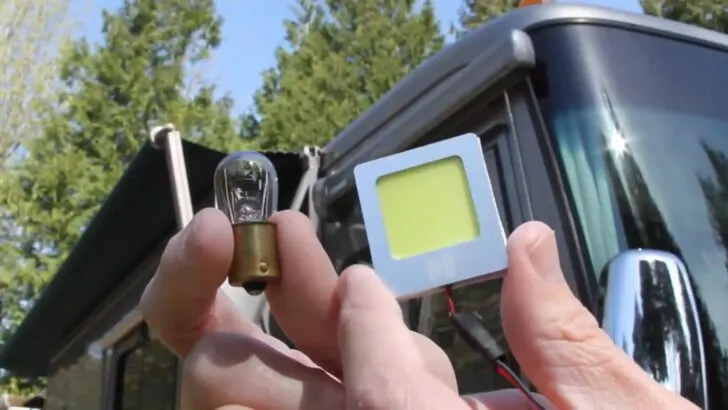
We replaced all of the incandescent, halogen, and fluorescent bulbs in our motorhome with LEDs to reduce both power consumption and heat output.
Heating and Cooling
Both the air conditioning and heating systems (even propane or diesel heating) in most RVs rely on electricity for operation. Some systems use a combination of 120V AC and 12V DC power.
Traditional air conditioners use 120V AC power to cool the RV but require 12V DC to manage the controls and thermostat. 12V RV air conditioners are becoming more popular, and those only need 12V DC power to operate.
Most RV heating systems are similar to traditional RV air conditioners, in that they use 12V DC power to manage and control them while using other energy sources (propane or diesel fuel) to generate heat. Similarly, heat pumps use 120V AC to heat, and 12V DC to manage the “brains” of the system.
We do heat our rig in two other ways, each of which requires only a single source of energy: 1) Portable electric space heaters for when we’re on shore power use only 120V AC, and 2) A portable propane heater, which uses zero electric power.
Water Heater
Other than smaller rigs without plumbing systems, most RVs are equipped with a water heater. Typically, a rig may have a Suburban or Atwood/Dometic water heater with a 6-12 gallon tank. Water is heated by a 120V AC electric heating element when on shore or generator power, or with propane when off the grid.
Regardless of which energy source you’re using to heat water (120V AC or propane), the electronics/brains of this type of heater usually require 12V DC power, similar to air conditioning and heating systems.
We upgraded our Mountain Aire’s water heater to a Truma AquaGo Comfort on-demand RV water heater. There are many benefits, and we love it, but one minor downside is that it heats water using propane only. So when we’re paying for an overnight or weekly stay in an RV park, where power is included, we’re using our own propane instead of the park’s power. The good news is that it sips propane, and all the other benefits far outweigh this one minor negative.
But even with our Truma water heater, the brains of the system require 12V DC power to operate. If you’re sensing a trend here, where it seems that many systems use more than one source of energy to accomplish their mission, you’re right. And RV refrigerators are no different.
RV Refrigeration
Traditional “RV” refrigerators can run on 120V AC power when connected to shore power or running a generator, or cool using propane when off the grid. “Three-way” RV fridges can also run directly off 12V DC power when the engine of a motorhome is running. This type of fridge is common in Class B vans, and we’ve seen them in our international RV travels as well. See our post What Is a 3-Way RV Refrigerator? for more details.
But regardless of what power source is used to cool an RV fridge, 12V DC is almost always used to control the brains of the fridge. (We’re starting to think that 12V DC power is smarter than other energy sources.) 😉
As you’d expect from an appliance that’s designed for a typical home, residential refrigerators run on 120V AC power only. One of the reasons we equipped our rig with so many solar panels and lithium batteries is to allow us to power our residential fridge when we’re boondocking, which we do a lot.
There is also a newer type of fridge that’s becoming more and more popular and common: 12V RV refrigerators. Just like a residential fridge, they use only a single source of energy for all functions (both cooling and temperature control/brains). As the name implies they use 12V DC power only.
While we’re on the subject, if you’ve wondered if your RV fridge will run off battery while you’re driving, check out our post on that topic.
Entertainment Systems
Most RVs offer the ability to run TVs, stereos, and other entertainment systems. These types of devices also draw power from the RV’s electrical system, typically running off of 12V DC power (12V DC television sets are becoming more and more common, especially in smaller RVs with less expansive power systems). Of course many RVs still have 120V AC TVs, but that’s getting less common every year.
Understanding how an RV’s electrical system works can be super helpful, especially when a problem crops up. Whether you’re connected to shore power, running a generator, or using your house battery bank, it’s helpful to know where your appliances, devices, and RV outlets get their power.
Free RVing Tips, Tricks, Reviews & Giveaways
As 20-year full-timers, we share everything we’ve learned about RVing over the years. Join our online community to receive a wealth of great RVing knowledge delivered daily to your inbox.
Whether you’re a new RVer or a seasoned full-timer, you’ll love the wide range of RVing topics we cover. Don’t miss a single article or any of our famous Giveaways. Subscribe to our newsletter today!




Phil Fonteyn
Wednesday 6th of December 2023
Off on a bit of a tangent here, but when it comes to "penetrating" an RV exterior wall to pass a wire through, has anyone tried to make a permanent hole to pass wires, such as, starlink, weather radio, cell phone extender etc? I find myself using the seal on a slide out but eventually that will wear out. Is there a gadget that I can drill a hole, say one inch diameter, through the exterior wall and cap each end while travelling, yet, when parked I can remove the caps and pass a wire(s) through?
TheRVgeeks
Wednesday 6th of December 2023
That's a really good question, Phil. And one we'll be watching to see if someone out there has a solution we've never encountered. Because this is the eternal difficulty... getting wires into/out of your RV in a watertight manner.
The permanent installations (weather radio, cell booster, etc) aren't as big an issue... since you can drill the hole, pass the wire through, and seal things up for good (either with caulk or with something like a cable clam, which are popular in marine applications). But when you've got a cable you have to constantly pass through the wall and then remove (Starlink), that's a bigger challenge.
Our suggestion would be to see if there's a spot where you could drill a hole through the floor and down into a basement compartment. The you can pass the cable through and leave one end inside all the time. The other end can be pulled out through the basement compartment door to set up... and you can usually (safely) shut the cable in the door... the soft seals will give and allow the cable through. And, since you're parked, you likely don't have to worry about water penetration. OR you can have another, sealable hole (using a kayak/deck plate) in the bottom of that basement compartment so you can easily open it to pass the cable through at camp (though you'll need one with a plate that can have a smaller opening for when the cable is there, like a cable port on top of a desk)... then seal it up once you're breaking camp.
Brad Wartman
Tuesday 5th of December 2023
Having an older rig we wanted to add inverter-based 120V power but could not come up with a good solution to integrate the inverter-based power with the existing 12/120V wiring. We only need a few outlets to meet some basic needs when we're boondocking and decided it wasn't worth the cost of ripping out the existing wiring/distribution center and installing an inverter/charger.
The solution I came up with was to install a separate set of 120V outlets wired directly to the inverter. The outlets were installed next to the existing 120V outlets and are both a different color, a cover labeled "Inverter", and an on/off indicator light to distinguish them from the non-inverter outlet.
Coupled with the LiFePO4 batteries we installed this spring the setup has worked very well for us, providing a source of 120V power when we're boondocking but still giving us the flexibility to run higher loads like the A/C from a generator when needed.
Grant Hoover
Tuesday 5th of December 2023
RV Geeks. Outstanding article. I started watching RV videos during COVID. It took me awhile to understand house power management.
My focus is on Class B/B+, which are offering more robust Lithium. One item I didn’t read was a second dedicated alternator to charge house batteries. I hear a lot of chatter about “Solar,” but it is that 2nd alternator that can charge a lot quicker. In fact, for a Class B, I don’t think solar is worth it – 200 to 400 watts – when you have a 10,000+ watt system.
Additionally, with Class B/B+, the longer-term goal is to forgo propane and generator. Plus, as your article mentions, there will be more emphasis 12V DC Power items like A/C, frig, heat pump, etc. Also, you need to be aware of “drain values” like commenter Jen Fugit mentioned.
Bottom line: if you in the market for a smaller, self-sufficient RV; you need to get up to speed on RV electrical systems because shore power and generators will not be the primary.
Steve
Tuesday 5th of December 2023
Where can I buy the book rv wiring for dummies.
Brad Wartman
Tuesday 5th of December 2023
Hi @Steve, check out this book:
https://amzn.to/41b2C25
Happy (and safe) travels!
Ray Davis
Tuesday 5th of December 2023
Hey Guys, Although I am knowlegeable with RV elec. I read your article, as I believe that sometimes, just one new item of information may be beneficial. You did a great job, in plain language and well articulated for all to understand. You are appreciated in the community. Ray